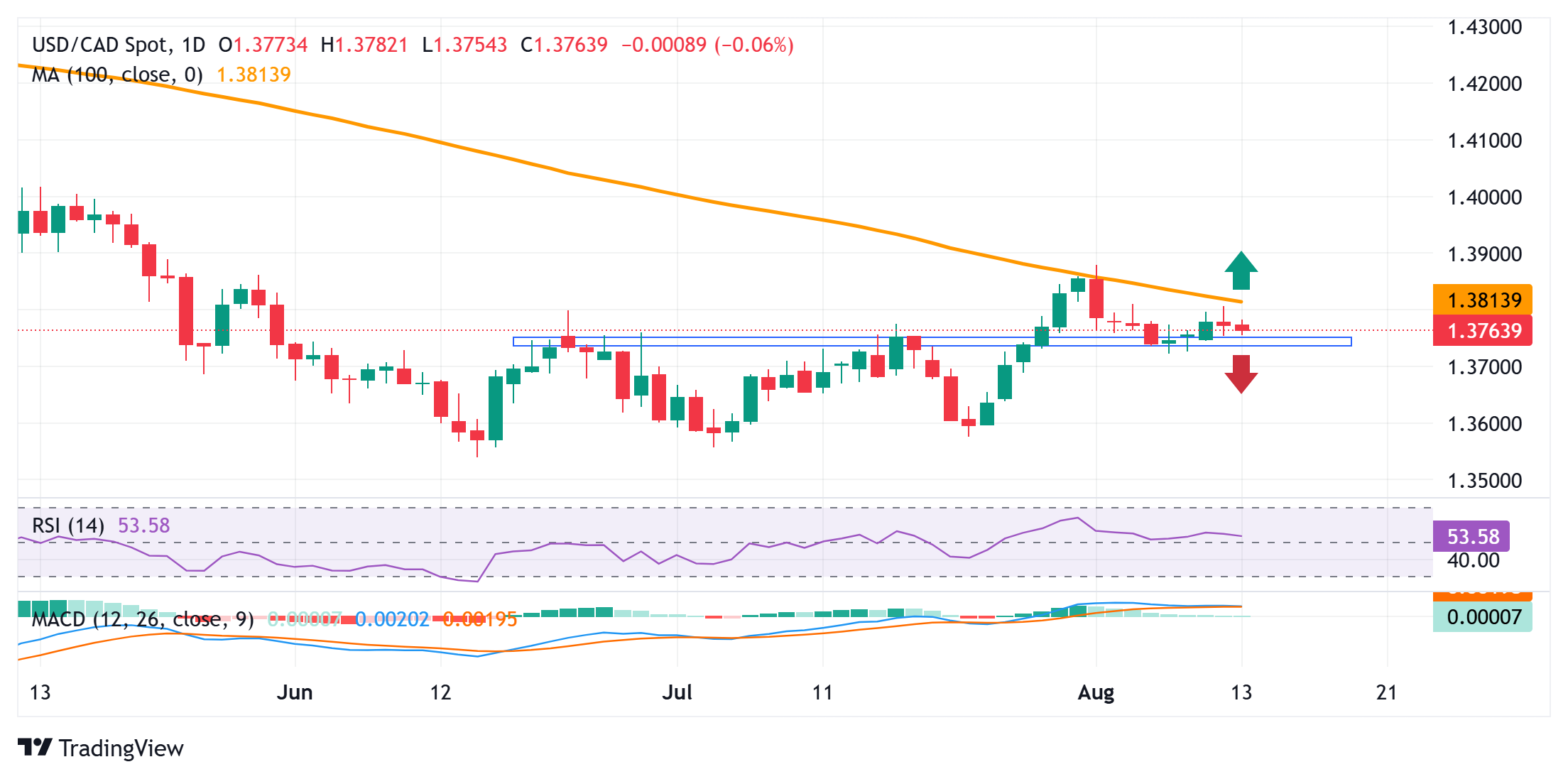
- USD/CAD drifts lower for the second straight day amid the post-US CPI USD selling bias.
- Mostly in-line US inflation figures reaffirm Fed rate cut bets and weigh on the buck.
- Bearish Oil prices, dovish BoC, and trade jitters undermine the Loonie and lend support.
The USD/CAD pair extends the previous day’s rejection slide from the 1.3800 mark and attracts some follow-through selling for the second straight day amid a bearish sentiment surrounding the US Dollar (USD). Traders are overwhelmingly betting that the US Federal Reserve (Fed) will lower borrowing costs by 25 basis points in September and deliver at least two interest rate cuts by the end of this year. The expectations were lifted by a series of disappointing US economic data released recently, including the closely-watched Nonfarm Payrolls (NFP) report, which pointed to deteriorating labor market conditions.
Adding to this, the US Bureau of Labor Statistics reported on Tuesday that the headline Consumer Price Index (CPI) remained unchanged at 2.7% on a yearly basis in July. However, the core gauge, which excludes food and energy prices, came in above market estimates and increased to the 3.1% YoY rate from the 2.9% in June. On a monthly basis, the CPI and the core CPI rose by 0.2% and 0.3%, respectively, matching expectations. Nevertheless, the data eased fears that trade-related costs may feed into broader price pressures and reinforced the narrative for an imminent interest rate cut by the Fed next month.
Furthermore, the underlying strong bullish sentiment, bolstered by an extension of the US-China trade truce and the US-Russia summit aimed at ending the war in Ukraine, turns out to be another factor undermining the safe-haven Greenback. However, bearish Crude Oil prices and dovish Bank of Canada (BoC) expectations keep a lid on any meaningful gains for the commodity-linked Loonie. Apart from this, trade-related uncertainties could undermine the Canadian Dollar (CAD) and help limit deeper losses for the USD/CAD pair, warranting some caution before positioning for any further depreciating move.
In the latest trade-related developments, China announced a 75.8% preliminary anti-dumping duty on Canadian canola imports on Tuesday in response to the latter’s tax on its electric vehicles. This comes on top of US President Donald Trump’s recent decision to lift the tariff rate on Canada from 25% to 35%. Moreover, the White House announced a 40% transshipment tariff on goods rerouted through third countries to avoid the duties. This further dampens the outlook for Canadian exports and could weigh on the domestic economy, which, in turn, could cap the CAD and offer support to the USD/CAD pair.
Moving ahead, there isn’t any relevant market-moving economic data due for release on Wednesday, either from the US or Canada. That said, speeches from influential FOMC members and the broader risk sentiment could drive the USD demand later during the North American session. Apart from this, Crude Oil price dynamics could provide some impetus to the USD/CAD pair and produce short-term trading opportunities. Nevertheless, the aforementioned fundamental backdrop makes it prudent to wait for strong follow-through selling before placing fresh bearish bets around the currency pair.
USD/CAD daily chart

Technical Outlook
The overnight failure ahead of the 100-day Simple Moving Average (SMA) and the subsequent slide favor the USD/CAD bears. However, slightly positive oscillators on the daily chart suggest that any further decline is more likely to find decent support near the 1.3740 area. However, some follow-through selling below last week’s swing low, around the 1.3720 area, could make spot prices vulnerable to weaken further below the 1.3700 mark, towards testing the next relevant support near mid-1.3600s. The downward trajectory could extend further towards the 1.3600 round figure en route to the year-to-date low, around the 1.3540 region touched in June.
On the flip side, the 1.3780-1.3785 region, or the daily high, now seems to act as an immediate hurdle ahead of the 1.3800 mark. This is closely followed by the 100-day SMA barrier, currently pegged near the 1.3815 area, above which a fresh bout of short-covering could lift the USD/CAD pair to the 1.3875-1.3880 region, or the monthly peak. Some follow-through buying, leading to a subsequent strength beyond the 1.3900 mark, would shift the bias in favor of bullish traders and allow spot prices to climb further to the 1.3950 region en route to the 1.4000 psychological mark.
Information on these pages contains forward-looking statements that involve risks and uncertainties. Markets and instruments profiled on this page are for informational purposes only and should not in any way come across as a recommendation to buy or sell in these assets. You should do your own thorough research before making any investment decisions. FXStreet does not in any way guarantee that this information is free from mistakes, errors, or material misstatements. It also does not guarantee that this information is of a timely nature. Investing in Open Markets involves a great deal of risk, including the loss of all or a portion of your investment, as well as emotional distress. All risks, losses and costs associated with investing, including total loss of principal, are your responsibility. The views and opinions expressed in this article are those of the authors and do not necessarily reflect the official policy or position of FXStreet nor its advertisers. The author will not be held responsible for information that is found at the end of links posted on this page.
If not otherwise explicitly mentioned in the body of the article, at the time of writing, the author has no position in any stock mentioned in this article and no business relationship with any company mentioned. The author has not received compensation for writing this article, other than from FXStreet.
FXStreet and the author do not provide personalized recommendations. The author makes no representations as to the accuracy, completeness, or suitability of this information. FXStreet and the author will not be liable for any errors, omissions or any losses, injuries or damages arising from this information and its display or use. Errors and omissions excepted.
The author and FXStreet are not registered investment advisors and nothing in this article is intended to be investment advice.








